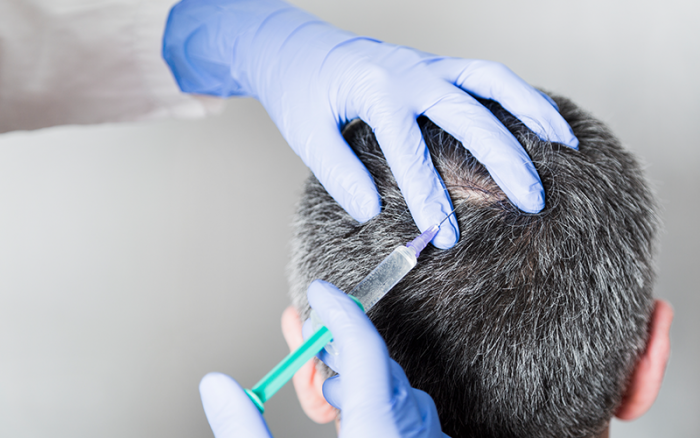Millions of men and women are confronted with some form of hair loss during their lifetimes. It can be an embarrassing problem that negatively affects your self-confidence, self-esteem and even quality of life.
In addition to all the prescription medications, laser therapies, surgical options and non-surgical options like NeoGraft, there is now a new hair replacement therapy that is showing very promising results: platelet-rich plasma (PRP) therapy. But does PRP for hair loss really work?
What Is Platelet-Rich Plasma Therapy?
Though platelet-rich plasma therapy is relatively new as a treatment for hair loss, it has actually been around a long time in the medical world. Doctors have used PRP therapy for coagulation, immune cell recruitment and even to help the healing process of surgical wounds.
Dermatologists have also used PRP therapy for years to rejuvenate skin and improve the appearance of facial tissue by promoting new cell growth. In this application, platelets are injected into targeted areas of the face to successfully remove fine lines and wrinkles. Today, this revolutionary therapy is being used to restore and stimulate hair growth by using a patient’s own platelets. Here is how PRP for hair loss works:
A small amount of blood (about the same as what is taken during a regular blood test) is drawn and then spun in a centrifuge to separate the platelets and plasma from the other blood components. Your platelets are unique because they secrete more than 300 substances that include all kinds of growth factors such as platelet-derived growth factor (PDGF), transforming growth factor (TGF), vascular endothelial growth factor (VEGF), insulin-like growth factor (IGF) and epidermal growth factor (EGF).
These growth factors not only help to repair cells — but they also stimulate hair growth and slow down male and female pattern baldness. Once the platelets and plasma have been separated from your blood, the platelet-rich plasma is then injected directly into the scalp.
For the best results, the PRP can be applied directly to the scalp topically and then driven deeper into the scalp through micro-needling or another device.
Typically, patients have the PRP delivered into their scalp by their dermatologist once a month for three consecutive months, then twice per year afterward for maintenance. Side effects are minimal — some swelling and redness at the injection site immediately following the procedure — and results can last for one year or even longer.
Does PRP for Hair Loss Really Work?
Platelet-rich plasma therapy for hair loss is still relatively new, but it is a promising and effective non-surgical option to treat both male and female pattern baldness by stimulating hair follicles to regrow hair.
A recent dermatological study conducted by the Department of Dermatology at NHL Municipal Medical College in India found PRP therapy combined with micro needling to be an effective treatment for patients with androgenic alopecia or male and female pattern baldness.
The study randomly divided 50 subjects into two groups. One group was given topical minoxidil (Rogaine) and the second group was given Rogaine in addition to PRP therapy combined with micro needling. After six months, the group that received PRP for hair loss showed significant hair regrowth and an increase in the thickness of the hair.
Hair loss affects everyone at some point in life and can be caused by many factors including your family history, age, stress level, and nutrition. It can even be related to some underlying medical conditions. The most common form of hair loss is male or female pattern baldness, which presents as a receding hairline or thinning area in the crown for men and a widening of the part or overall hair loss in women.
Though PRP therapy can greatly improve the appearance and thickness of your hair, it won’t completely reverse hair loss. The best results are typically seen with patients who have thinning hair or who are exhibiting symptoms of male or female pattern baldness.
“Platelet-rich plasma therapy won’t cure baldness. For patients who are completely bald, the therapy won’t effectively grow new hair. But for those with thinning hair, it can promote the production of new hair, strengthen the hair follicles and make the hair appear much thicker,” says Dr. Hans M. Sander, a board-certified dermatologist with U.S. Dermatology Partners Jollyville.
Looking to Visit a Dermatologist?
If hair loss is negatively affecting your self-confidence or quality of life, talk to your doctor about the causes of your hair loss and if platelet-rich plasma therapy might be a good fit for you. To learn more about PRP for hair loss and other treatment options, contact one of our board-certified dermatologists at U.S. Dermatology Partners today. We have multiple locations throughout the country, so fill out our simple online form to get in touch with us. One of our local team members will reach out to you shortly to answer your questions or schedule an appointment for you to visit us soon.
Find a location near me
or

